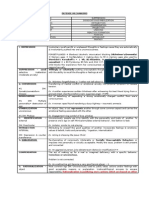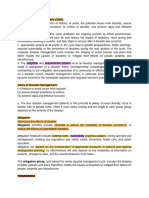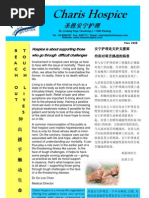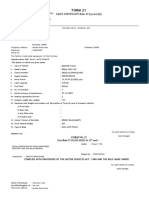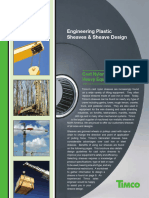Defense Mech Stress Psych Midterms
Defense Mech Stress Psych Midterms
Uploaded by
mendozajanice0601Copyright:
Available Formats
Defense Mech Stress Psych Midterms
Defense Mech Stress Psych Midterms
Uploaded by
mendozajanice0601Copyright
Available Formats
Share this document
Did you find this document useful?
Is this content inappropriate?
Copyright:
Available Formats
Defense Mech Stress Psych Midterms
Defense Mech Stress Psych Midterms
Uploaded by
mendozajanice0601Copyright:
Available Formats
Ego Defense Mechanism ▪ Example: An individual states that she didn’t
Defense mechanism win the race because she hadn’t gotten a good
Mental mechanism night’s sleep.
Identification
▪ These are mental processes that are usually ▪ Unconsciously, people use it in an attempt to
unconscious, protective barriers that are used identify with the personality and traits of
to manage instinct and affect in the presence of others.
stressful situations Reaction formation
▪ Defense mechanisms are thought to safeguard ▪ The person exaggerates or overdevelops certain
the mind against feelings and thoughts that are actions by displaying exactly the opposite
too difficult for the conscious mind to cope behavior, attitude or feelings from what he
with. normally would show in a given situation.
Functions of Defense Mechanism ▪ This mechanism is considered a protective drive
▪ To resolve mental conflict by which the person prevents painful,
undesirable, or unacceptable attitudes toward
▪ To reduce anxiety or fear others from emerging.
▪ To protect one’s self esteem ▪ An example of reaction formation would be
treating someone you strongly dislike in an
▪ To protect one’s sense of security excessively friendly manner in order to hide
your true feelings.
Kinds of Defense Mechanisms Substitution
Suppression ▪ The unconscious act or replacing a goal when it
▪ Willfully or voluntarily putting an unacceptable is blocked.
thought of feeling out of one’s mind with the ▪ It is also defined as the replacement of
ability to recall the thought or feeling at will.
consciously unacceptable emotions, drives,
Repression
attitudes or needs by those that are more
▪ Repression refers to unconsciously blocking out acceptable
painful or unacceptable thoughts and feelings, Displacement
leaving them to operate in the subconscious. ▪ A mechanism that serves to transfer feelings
▪ The person is unable to recall painful or such as frustration, hostility, or anxiety from one
unpleasant thoughts and feelings because they idea, person, or object to another.
are automatically and involuntarily pushed into ▪ The substitute target is less threatening and
one’s consciousness.
allows the person to release emotional
▪ Example: A woman who was sexually abused as reactions
a young child can’t remember the abuse but
experiences uneasy feelings when she goes near
the place where the abuse occurred. Restitution or Undoing
Compensation ▪ the negation of previously consciously
▪ The act of making up for a real or imagined intolerable action or experiences to reduce or
inability or deficiency with a specific behavior to alleviate feelings of guilt.
maintain self-respect or self-esteem ▪ Making up for wrongdoings
Rationalization
▪ Trying to make up for what one feels are
▪ This is used unconsciously to justify ideas,
inappropriate thoughts, feelings, or behaviors
actions, or feelings with good, acceptable
(e.g., if you hurt someone's feelings, you might
reasons or explanations.
offer to do something nice for them in order to
▪ It is used to maintain self-respect, prevent guilt assuage your anxiety or guilt)
feelings, and obtain social approval or ▪ A patient who says something bad about a
acceptance.
friend may try to undo the harm by saying nice
▪ Rationalization not only prevents anxiety, but it things about her or by being nice to her and
may also protect self-esteem and self-concept. apologizing.
Projection
▪ The rationalizing patient makes excuses for
▪ The person rejects unwanted characteristic of
shortcomings and avoids self-condemnation,
displacements, and criticisms. self and assigns them to others.
▪ The person may blame others for faults, ▪ The transferring of mental conflict into a
feelings, or shortcomings that are unacceptable physical symptom to release tension or anxiety
to self. Fantasy
▪ Example: A student who fails a test blames his ▪ Imagined events or mental images to express
parents for having the television on too loud unconscious conflicts, gratify unconscious
when he was trying to study. wishes, or prepare for anticipated future events.
Symbolization
▪ Fantasy refers to creation of unrealistic or
▪ An object, idea or act represents another improbable images as a way of escaping from
through some common aspect and carries the daily pressures and responsibilities or to relieve
emotional feeling associated with the other. boredom.
▪ External objects may become outward ▪ Example: A person may daydream excessively,
representations of internal ideas, attitudes or watch TV for hours on end, or imagine being
feelings highly successful when he feels unsuccessful.
Regression Engaging in such activities makes him feel better
for a brief period.
▪ Retreating to past levels of behavior that reduce
Isolation
anxiety, allow one to feel more comfortable,
and permit dependency. ▪ The process of separating an unacceptable
feeling, idea, or impulse from one’s thoughts.
▪ Returning to earlier level of psychosocial
development. ▪ Also referred as emotional isolation
▪ Under stress, persons may regress by returning
to the behaviors they used in an earlier, more Dissociation
comfortable time in their lives.
▪ The act of separating and detaching a strong
▪ Example: A previously toilet-trained preschool
emotionally charged conflict from one’s
child begins to wet his bed every night after his consciousness.
baby brother is born.
Sublimation ▪ This detached information is blocked from
conscious awareness which allows the person to
▪ The rechanneling of consciously intolerable or
defer or postpone experiencing an emotional
socially unacceptable impulses or behaviors into impact or painful feelings.
activities that are personally or socially Intellectualization
acceptable.
▪ The act of transferring emotional concerns into
▪ For example, a person experiencing extreme
intellectual sphere.
anger might take up kick-boxing as a means of
venting frustration. ▪ The person uses reasoning as a means of
Denial avoiding confrontation with unconscious
conflicts and their stressful emotions.
▪ The unconscious refusal to face thoughts,
feelings, wishes, needs or reality factors that are ▪ Intellectualization works to reduce anxiety by
intolerable. thinking about events in a cold, clinical way.
▪ It is also defined as blocking the awareness of ▪ This defense mechanism allows us to avoid
reality by refusing to acknowledge its existence. thinking about the stressful, emotional aspect
of the situation and instead focus only on the
▪ A person in denial protects himself from reality
intellectual component.
– especially the unpleasant aspects of life – by
refusing to perceive, acknowledge, or face it. ▪ For example, a person who has just been
diagnosed with a terminal illness might focus on
▪ Example: A woman newly diagnosed with
learning everything about the disease in order
end-stage-cancer says, “I’ll be okay, it’s not a big to avoid distress and remain distant from the
deal”. reality of the situation.
Introjection Passive- aggression
▪ Attributing to oneself the good qualities of ▪ Indirectly expressing aggression toward others.
another; symbolically taking on the character
traits of another person by ‘ingesting’ the ▪ A façade of overt compliance masks covert
philosophy, ideas, knowledge, customs, mores resentment
or attitudes of that other person. Acting out
Conversion
▪ Coping with stress by engaging in actions rather
than acknowledging and bearing certain feelings
Altruism
▪ Adaptation – Body’s adjustment to different
▪ Satisfying internal needs through helping others circumstances and conditions. Process by the
physiological or psychological dimensions
Stress change in response to stress; attempt to
maintain optimal functioning
Theory by Hans Selye
Adaptation to Stress-Physiological Response (Hans
▪ Non-specific response of the body to any Selye)
demand made upon it. Local Adaptation Syndrome (LAS)
▪ Any situation in which a non-specific demand Response of a body tissue, organ or part to the stress of
trauma, illness or other physiological change.
requires an individual to respond or take action
Characteristics
Characteristics of Stress
▪ The response is localized, it does not involve
▪ Stress is not nervous energy. Emotional
entire body systems
reactions are common stressors
▪ The response is adaptive, meaning that a
▪ Stress is not always the result of damage to the
stressor is necessary to stimulate it
body
▪ The response is short term. It does not persist
▪ Stress does not always result in feelings of
indefinitely
distress (harmful or unpleasant stress)
▪ The response is restorative, meaning that the
▪ Stress is a necessary part of life and is essential
LAS assists in restoring homeostasis to the body
for normal growth and development region or part
▪ Stress involves the entire body acting as a whole Two Localized Responses
and is an integrated manner 1. Reflex Pain Response – is a localized response of
the central Nervous system to pain. It is an
▪ Stress response is natural, productive and adaptive response and protects tissue from
adaptive further damage.
✔ The response involves a sensory receptor, a
Stressors
sensory nerve from the spinal cord, and an
▪ Factor or agent producing stress, maybe: effector muscle
physiological, psychological, social,
✔ An example would be the unconscious, reflex
environmental, developmental, spiritual or
cultural and represent an unmet need removal of the hand from a hot surface. It
would be a good idea to consider the cannabis
Classification of Stressors strain for those struggling with reflex pain,
people heard from some individuals that
▪ Internal Stressors – originate from within the cannabis can help reduce pain and improve pain
body. E.g. fever, pregnancy, menopause, management.
emotion such as guilt 2. Inflammatory Response – is stimulated by
▪ External Stressors – originate outside a person. trauma or infection. This response localizes the
inflammation, thus revenging its spread and
E.g. change in family or social role, peer promotes healing.
pressure, marked change in environmental
temperature ✔ The inflammatory response may produce
localized pain, swelling, heat, redness and
Factors influencing response to stressors changes in functioning.
▪ Physiological functioning
Three Phases of Inflammatory Response
▪ Personality ▪ First Phase – Narrowing of blood vessels occurs
▪ Behavioral characteristics at the injury to control bleeding. Then histamine
is released at the injury, increasing the number
▪ Nature of the stressor: integrity, scope, of white blood cells to combat infection.
duration, number, and nature of other stressors ▪ Second Phase – It is characterized by release of
▪ Homeostasis – Process of maintaining exudates from the wound
uniformity, stability and constancy with in the ▪ Third Phase – The last phase is repair of tissue
living organisms. (From Greek word homotos –
like, and stasis – position) by regeneration or scar formation. Regeneration
replaces damaged cells with identical or similar
cells.
▪ Sodium & water retention increase due to
General Adaptation Syndrome (GAS) or Stress
Syndrome release of mineralocorticoids, which results in
Characterized by a chain or pattern of physiologic increased blood volume.
events. ▪ The rate & depth of respirations increase
because of dilation of the bronchioles,
3 Stages promoting hyperventilation.
▪ Alarm Reaction – initial reaction of the body ▪ Urinary output may increase or decreases.
which alerts the body’s defenses. SELYE divided
this stage into 2 parts: ▪ The mouth may be dry.
The SHOCK PHASE
▪ Peristalsis of the intestines decreases, resulting
The COUNTERSHOCK PHASE
in possible constipation and flatus.
▪ Stage of Resistance – occurs when the body’s
▪ For serious threats, mental alertness improves.
adaptation takes place; the body attempts to
adjust with the stressor and to limit the stressor ▪ Muscle tension increases to prepare for rapid
to the smallest area of the body that can deal motor activity or defense.
with it.
▪ Blood sugar increases because of release of
▪ Stage of Exhaustion – the adaptation that the
glucocorticoids & gluconeogenesis.
body made during the second stage cannot be
maintained; the ways used to cope with the
stressors have been exhausted Psychologic Indicators
Stressors
▪ Psychologic manifestations of stress include
▪ Stimulate the sympathetic nervous system,
anxiety, fear, anger, depression & unconscious
which in turn stimulates the hypothalamus. ego defense mechanisms.
▪ The HYPOTHALAMUS releases corticotrophin ▪ Anxiety – a common reaction to stress. It is a
releasing hormone (CRH). During times of state of mental uneasiness, apprehension,
stress, the ADRENAL MEDULLA secretes dread, or foreboding or a feeling of helplessness
EPINEPHRINE & NOREPINEPHRINE in response related to an impending or anticipated
to sympathetic stimulation. unidentified threat to self or significant
▪ Significant body responses to epinephrine relationships.
include the following: ▪ Fear – an emotion or feeling of apprehension
✔ Increased myocardial contractility, aroused by impending or seeming danger, or
which increases cardiac output & blood other perceived threat. The object of fear may
flow to active muscles or may not be based in reality.
✔ Bronchial dilation, which allows ▪ Anger – an emotional state consisting of a
increased oxygen intake subjective feeling of animosity or strong
displeasure. People may feel guilty when they
✔ Increased blood clotting feel anger because they have been taught that
✔ Increased cellular metabolism to feel angry is wrong.
▪ Depression – common reaction to events that
✔ Increased fat mobilization to make
seem overwhelming or negative. It is an
energy available & to synthesize other extreme feeling of sadness, despair, dejection,
compounds needed by the body. lack of worth or emptiness.
Physiologic Indicators of Stress ✔ Emotional symptoms can include:
▪ Pupils dilate to increase visual perception when Feelings of tiredness, sadness,
emptiness, or numbness
serious threats to the body arise.
✔ Behavioral signs include: Irritability,
▪ Sweat production (diaphoresis) increases to
inability to concentrate, difficulty
control elevated body heat due to increased making decisions, loss of sexual desire,
metabolism. crying, sleep disturbance and social
▪ The heart rate & cardiac output increase to withdrawal.
transport nutrients and by-products of ✔ Physical signs include: Loss of appetite,
metabolism more efficiently. weight loss, constipation, headache and
▪ Skin is pallid because of constriction of dizziness
peripheral vessels, an effect of norepinephrine. Cognitive Indicators
These are thinking responses that include
✔ Past experiences of the individual
problem-solving, structuring, self-control or
self-discipline, suppression and fantasy ✔ Support systems available to the
▪ Problem solving – involves thinking through the individual
threatening situation, using a specific step to ✔ Personal qualities of the person
arrive at a solution
▪ If the duration of the stressors is extended
▪ Structuring – arrangement or manipulation of a
beyond the coping powers of the individual,
situation so that threatening events do not that person becomes exhausted and may
occur. develop increased susceptibility to health
▪ Self-Control (discipline) – assuming a manner of problems.
facial expression that convey a sense of being in ▪ Reaction to long term stress is seen in family
control or in change. members who undertake the care of a person in
▪ Suppression – consciously and willfully putting a the home for a long period. This stress is called
thought or feeling out of mind caregiver burden & produces responses such as
chronic fatigue, sleeping difficulties & high BP.
▪ Fantasy – (daydreaming) – likened to make
▪ Prolonged stress can also result in mental
believe. Unfulfilled wishes & desires are
imagined as fulfilled, or a threatening illness.
experience is reworked or replayed so that it
ends differently from reality. Relaxation Techniques
Coping Strategies (Coping Mechanisms) Used to quiet the mind, release tension & counteract the
fight or flight responses of General Adaptation
▪ Coping – dealing with problems & situations or Syndrome (GAS).
contending with them successfully.
▪ Breathing Exercises
▪ Coping Strategy – innate or acquired way of
▪ Massage
responding to a changing environment or
specific problem or situation. ▪ Progressive Relaxation
▪ According to Folkman and Lazarus, coping is ▪ Imagery
“the cognitive & behavioral effort to manage
specific external and/ or internal demands that ▪ Biofeedback
are appraised as taxing or exceeding the
▪ Yoga
resources of the person”.
▪ Meditation
Coping Strategies: 2 Types
1. Problem-focused coping – efforts to improve a ▪ Therapeutic Touch
situation by making changes or taking some action
▪ Music Therapy
2. Emotion-focused coping – does not improve the
situation, but the person often feels better. ▪ Humor & Laughter
Coping strategies are also viewed as:
Psychological Response
1. Long-term coping strategies – can be constructive &
realistic ▪ Exposure to a stressor results in psychological
2. Short-term coping strategies – can reduce stress to a and physiological and physiological adaptive
tolerable limit temporarily but are in the end of responses. As people are exposed to a stressor,
ineffective ways to deal with reality. their ability to meet their basic needs is
threatened. This threat whether actual or
Coping can be adaptive or maladaptive perceived, produces frustration, anxiety and
1. Adaptive Coping – helps the person to deal tension.
effectively with stressful events & minimizes distress
▪ Psychological adaptive behaviors assist the
associated with them.
2. Maladaptive Coping – can result in unnecessary person’s ability to cope with stressors.
distress for the person & others associated with the ▪ These behaviors are directed at stress
person or stressful event.
management and are acquired through learning
▪ Effective coping results in adaptation; and experience as a person identifies acceptable
ineffective coping results in maladaptation. The and successful behaviors.
effectiveness of an individual’s coping is ▪ Psychological adaptive behaviors are also
influenced by a number of factors:
related to as COPING MECHANISMS. It involves:
✔ The number, duration & intensity of the 1. Task – Oriented Behaviors – Involve using cognitive
stressors abilities to reduce stress, solve problems, resolve
conflicts and gratify needs. It enables a person to cope
realistically with the demands of a stressor.
Three General Types:
▪ Attack Behavior – Is acting to remove or
overcome a stressor or to satisfy a need
▪ Withdrawal Behavior – Is removing the self
physically or emotionally from the stressor
▪ Compromise Behavior – Is changing the usual
method of operating, substituting goals or
omitting the satisfaction of needs to meet other
needs or to avoid stress.
2. Defense Mechanisms – Unconscious behaviors that
offer psychological protection from a stressful event.
▪ They are used by everyone and help protect
against feelings of worthlessness and anxiety.
▪ Frequently activated by short-term stressors
and usually do not result in psychiatric
disorders.
You might also like
- CASE STUDY - Nirma V.S HulDocument4 pagesCASE STUDY - Nirma V.S HulRicha Shruti0% (1)
- Key - 8th Grade Mental Emotional Health Study GuideDocument2 pagesKey - 8th Grade Mental Emotional Health Study Guideapi-263456844No ratings yet
- Communication and Defense MechanismDocument49 pagesCommunication and Defense MechanismFirda Annisya ToniNo ratings yet
- Building Emotional CompetenceDocument2 pagesBuilding Emotional CompetenceRonan Ferrer100% (2)
- Defense MechanismsDocument4 pagesDefense Mechanismswisdumb rantsNo ratings yet
- Defense MechanismsDocument3 pagesDefense MechanismsPatrick Formoso100% (3)
- Defense MechanismDocument64 pagesDefense MechanismHamna ManafNo ratings yet
- css presentation empathyDocument27 pagescss presentation empathyBhakti patilNo ratings yet
- TAKING-CHARGE-OF-ONES-HEALTHDocument20 pagesTAKING-CHARGE-OF-ONES-HEALTHelvocxs elNo ratings yet
- Presentation On Defence MechanismDocument35 pagesPresentation On Defence MechanismELISION OFFICIALNo ratings yet
- Defense MechanismsDocument4 pagesDefense MechanismsemanNo ratings yet
- TAT Defense Mechanisms Edited 24062020 015456pm 30122022 095458am 19052023 073531pm 25092023 105954amDocument31 pagesTAT Defense Mechanisms Edited 24062020 015456pm 30122022 095458am 19052023 073531pm 25092023 105954amShanzaeNo ratings yet
- 14-EMOTIONAL-SELFDocument25 pages14-EMOTIONAL-SELFJames De LeonNo ratings yet
- Unit 3.2 Socialization Process.pptxDocument13 pagesUnit 3.2 Socialization Process.pptxBharat mahan RaiNo ratings yet
- ABPSYCHDocument3 pagesABPSYCHchristinamelicadoNo ratings yet
- Defense MechanismsDocument36 pagesDefense Mechanismsf9fq4x8qvnNo ratings yet
- DEFENCE_MECHANISM_rehab-039Document17 pagesDEFENCE_MECHANISM_rehab-039ShakthiNo ratings yet
- Behavior Defence MechanismsDocument30 pagesBehavior Defence MechanismsKeto RamishviliNo ratings yet
- Defense MechanismDocument8 pagesDefense MechanismOliver Miguel ChavezNo ratings yet
- kepy108-10Document1 pagekepy108-10riddhimaheshwari08No ratings yet
- Aillant S Categorization of Defense Mechanisms Level 1 - PathologicalDocument4 pagesAillant S Categorization of Defense Mechanisms Level 1 - PathologicalIoana Estela PătrulescuNo ratings yet
- Defence Mechanism-convertedDocument29 pagesDefence Mechanism-convertedmariaNo ratings yet
- 6. Mental Defence Mechanisms 2023Document15 pages6. Mental Defence Mechanisms 2023mushongamelindaNo ratings yet
- Itp Quiz Reviewer Finals Part 2Document21 pagesItp Quiz Reviewer Finals Part 2Micaella AnneNo ratings yet
- PSYCHOSOCIAL THEORIES AND THERAPY WK 3 4Document23 pagesPSYCHOSOCIAL THEORIES AND THERAPY WK 3 4lynmercadejas27No ratings yet
- Psychiatric Nursing ReviewerDocument20 pagesPsychiatric Nursing ReviewerLezel LaracasNo ratings yet
- Defense MechanismDocument11 pagesDefense MechanismJomar Jerome SinsonNo ratings yet
- Segment 6 CopingDocument39 pagesSegment 6 CopingverbokristinejoyNo ratings yet
- Chapter 3 Ego Defense MechanismsDocument50 pagesChapter 3 Ego Defense MechanismsmalindaNo ratings yet
- Anxiety Disorders 1Document13 pagesAnxiety Disorders 1lunawriteesNo ratings yet
- Mechanism Description Example Repression: E.G. OutfitDocument1 pageMechanism Description Example Repression: E.G. OutfitJudithB.Timbal-DigalNo ratings yet
- Defensive Coping: Nidhi Dewangan Ba-Iii YearDocument8 pagesDefensive Coping: Nidhi Dewangan Ba-Iii YearNidhi DNo ratings yet
- Behavioural Science 2Document27 pagesBehavioural Science 2Aiswarya ManojkumarNo ratings yet
- Chapter 1 Nature of Psychology - Part 2Document49 pagesChapter 1 Nature of Psychology - Part 2digvijaya03No ratings yet
- Anxiety and Surgery UNTAD 2012Document35 pagesAnxiety and Surgery UNTAD 2012Muhammad mukramNo ratings yet
- Defense MechanisimsDocument4 pagesDefense Mechanisimsdivya lavaniaNo ratings yet
- Ego Defense MechanismDocument5 pagesEgo Defense Mechanismmarie100% (24)
- Defense MechanismDocument14 pagesDefense MechanismLarry Dave LizardoNo ratings yet
- A08 - The Anxious Personality - NotesDocument2 pagesA08 - The Anxious Personality - NotesMinh Anh DangNo ratings yet
- Counselling Psychology 07Document26 pagesCounselling Psychology 07Saif RahmanNo ratings yet
- Mistaken Goal ChartDocument1 pageMistaken Goal ChartNatália ColomboNo ratings yet
- Self-Esteem: A Self Help GuideDocument16 pagesSelf-Esteem: A Self Help GuideNgay Tro Ve100% (1)
- Defense MechanismsDocument3 pagesDefense MechanismsJennifer JohnstonNo ratings yet
- Defense Mechanism 439.PptxDocument16 pagesDefense Mechanism 439.PptxbluesyranaNo ratings yet
- Grief Loss and Dying Week 11Document18 pagesGrief Loss and Dying Week 11Shaquilla TrappNo ratings yet
- Defense Mech - Written ReportDocument7 pagesDefense Mech - Written ReportDump AccNo ratings yet
- Psychological Defense Mechanisms PDFDocument12 pagesPsychological Defense Mechanisms PDFRajna SušanjNo ratings yet
- L 2 personality.pdfDocument68 pagesL 2 personality.pdfseifahmed557fNo ratings yet
- NCM105Document2 pagesNCM105ROxanne S. RendonNo ratings yet
- Mental Health: Psychiatric Nursing Bsn-3A PrelimDocument4 pagesMental Health: Psychiatric Nursing Bsn-3A PrelimEunice MañalacNo ratings yet
- Defense MechanismsDocument5 pagesDefense Mechanismsnmyza89No ratings yet
- Defense Mechanisms DefinedDocument4 pagesDefense Mechanisms DefinedkatrinasdNo ratings yet
- Defense MechanismDocument33 pagesDefense MechanismShiela Mae Llarenas LoretoNo ratings yet
- Defence MechanismsDocument11 pagesDefence MechanismsAneela khanNo ratings yet
- NCM 117 A Lec / W3 / Akba: TheoryDocument3 pagesNCM 117 A Lec / W3 / Akba: TheoryAngeli Kristiana AlejandrinoNo ratings yet
- Defense Mechanisms HandoutDocument1 pageDefense Mechanisms HandoutV_FreemanNo ratings yet
- Defense Mechanisms PresentationDocument32 pagesDefense Mechanisms PresentationprincessriyagulNo ratings yet
- Understanding Anger: The Emotional Response CycleDocument3 pagesUnderstanding Anger: The Emotional Response CycleBook ReaderNo ratings yet
- Primitive Defense MechanismsDocument4 pagesPrimitive Defense MechanismsKim Perez100% (2)
- PsychDocument28 pagesPsychCiena MaeNo ratings yet
- Anger Management Simplicity: Short Simplicity to Keep Your Anger in CheckFrom EverandAnger Management Simplicity: Short Simplicity to Keep Your Anger in CheckNo ratings yet
- Skills Disaster FinalsDocument5 pagesSkills Disaster Finalsmendozajanice0601No ratings yet
- Study PlanDocument1 pageStudy Planmendozajanice0601No ratings yet
- Quizzes NCM116Document10 pagesQuizzes NCM116mendozajanice0601No ratings yet
- NeurotransmittersDocument7 pagesNeurotransmittersmendozajanice0601No ratings yet
- LM FinalsDocument19 pagesLM Finalsmendozajanice0601No ratings yet
- Congestive and Cardiogenic DiseaseDocument11 pagesCongestive and Cardiogenic Diseasemendozajanice0601No ratings yet
- 123 Chart PatternDocument7 pages123 Chart Patternfxtechkannan100% (1)
- Nov2008 EbulletinDocument4 pagesNov2008 Ebulletincharishp8480No ratings yet
- Flight Engineer Knowledge Test Guide: FAA-G-8082-9Document51 pagesFlight Engineer Knowledge Test Guide: FAA-G-8082-9Usman Rafiq100% (1)
- Medication AdministrationDocument134 pagesMedication Administrationaryanmohamad210No ratings yet
- Article Careers360 20240530033841Document23 pagesArticle Careers360 20240530033841parthpashu1No ratings yet
- Circuit Simulation With SpiceDocument6 pagesCircuit Simulation With SpicejmdelacruzNo ratings yet
- Awareness On Solid Waste Management of The Senior High School Learners of The Lyceum of AparriDocument38 pagesAwareness On Solid Waste Management of The Senior High School Learners of The Lyceum of AparriFrankie Angelic100% (1)
- Order Management System MultiISP FunctionalityDocument6 pagesOrder Management System MultiISP Functionalitykk81No ratings yet
- Lesson 3 RWDocument38 pagesLesson 3 RWAngel PragadosNo ratings yet
- Download Full Fortune Academy Underworld #5 (Fortune Academy #5) 1st Edition J.R. Thorn [Thorn PDF All ChaptersDocument50 pagesDownload Full Fortune Academy Underworld #5 (Fortune Academy #5) 1st Edition J.R. Thorn [Thorn PDF All Chaptersbotchpoots4x100% (2)
- Class 10 Life Process Biology Notes On Nutrition PDFDocument8 pagesClass 10 Life Process Biology Notes On Nutrition PDFkrishnareddy_chintalaNo ratings yet
- Kumpulan Soal Soal BHS Inggris MinatDocument14 pagesKumpulan Soal Soal BHS Inggris Minatayya thNo ratings yet
- SOAL PAS B. INGGRIS SMA IT KLS X SEM Ganjil 2021-2022Document7 pagesSOAL PAS B. INGGRIS SMA IT KLS X SEM Ganjil 2021-2022Rahmat Randi Al BangkawyNo ratings yet
- Funai 46fd753p-10 A39q1epDocument45 pagesFunai 46fd753p-10 A39q1epBarsbold AvirmedNo ratings yet
- Form 21 SANT AUTO CO. (13383) : SALES CERTIFICATE Rule 47 (A) and (B)Document2 pagesForm 21 SANT AUTO CO. (13383) : SALES CERTIFICATE Rule 47 (A) and (B)shantiautoco2023No ratings yet
- SECOND QUARTER EXAM - Attempt Review PEDocument16 pagesSECOND QUARTER EXAM - Attempt Review PEneiljohn geraldez100% (1)
- PART B. MARKETING PLAN FOR ETEEAP Students 1Document7 pagesPART B. MARKETING PLAN FOR ETEEAP Students 1Ralf NitudaNo ratings yet
- Sap-Gui Installation GuaideDocument7 pagesSap-Gui Installation GuaideVinicius RosaNo ratings yet
- Stirling BoilerDocument14 pagesStirling BoilerDr. BIBIN CHIDAMBARANATHANNo ratings yet
- Sheave Design - TimcoDocument10 pagesSheave Design - TimcotungNo ratings yet
- The Anatomy of Exposition:: Logos, Ethos, and PathosDocument15 pagesThe Anatomy of Exposition:: Logos, Ethos, and PathosJohn LukezicNo ratings yet
- Den DR OlogyDocument436 pagesDen DR OlogyCBSE UGC NET EXAMNo ratings yet
- RhinitisDocument14 pagesRhinitisMayur IngaleNo ratings yet
- Sequence 2 Lesson1 by Asma Smile 2 AMDocument2 pagesSequence 2 Lesson1 by Asma Smile 2 AMthe rose of snow زهرة الثلجNo ratings yet
- Radiologia GeneralidadesDocument303 pagesRadiologia GeneralidadesIván Torres100% (1)
- A Tribute To Benjamin Graham by Irving KahnDocument1 pageA Tribute To Benjamin Graham by Irving Kahnpjs15No ratings yet
- Cellular AberrationDocument73 pagesCellular AberrationKim AmadoNo ratings yet
- Chapter 12eng Computer System OverviewDocument25 pagesChapter 12eng Computer System OverviewEditorial BranchNo ratings yet




































